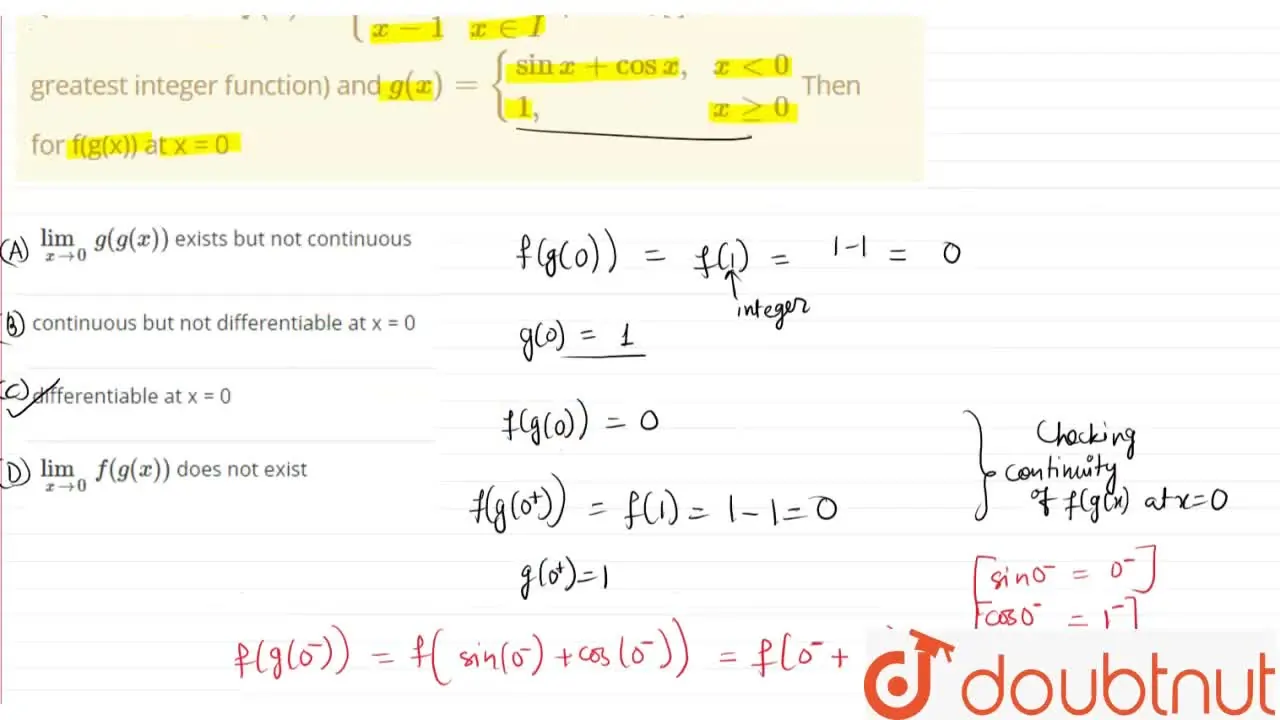Let y(x) be a solution of the differential equation (1+ex)y′+yex=1. If y(0)=2 , then which of the following statements is (are) true? (a) (b)(c)y((d)(e)−4(f))=0(g) (h) (b) (i)(j)y((k)(l)−2(m))=0(n) (o) (c) (d)(e)y((f)x(g))(h) (i) has a critical point in the interval (j)(k)((l)(m)−1,0(n))(o) (p) (q) (r)(s)y((t)x(u))(v) (w) has no critical point in the interval (x)(y)((z)(aa)−1,0(bb))(cc) (dd)
y(−4)=0
y(−2)=0
y(x) has a critical point in the interval (−1,0)
y(x) has no critical point in the interval (−1,0)
The correct Answer is:A, C
We have (1+ex)dydx+yex=1
⇒dydx+ex1+exy=11+ex (Linear differential equation)
I.F.=e∫(ex1+ex)=1+ex
Therefore, solution is
y1+exy=x+c
or (1+ex)y=x+c
Given, x=0,y=2, so c=4
∴y=x+4ex+1
y(−4)=0
y(−2)=2e−2+1
dydx=(ex+1).1−(x+4)ex(ex+1)2
=ex(−x−3)+1(ex+1)2
When dydx=0, then x+3=e−x
Graphs of y=x+3 and y=e−x are as shown in the following figure.

Clearly, graphs intersect for x∈(−1,00
Hence, y(x) has a critical point in the interval (−1,0)
Related Playlists
- BOOK - CENGAGE ENGLISHCHAPTER - DIFFERENTIAL EQUATIONSEXERCISE - Single Correct Answer Type37videos
DIFFERENTIAL EQUATIONS
- BOOK - CENGAGE ENGLISHCHAPTER - DIFFERENTIAL EQUATIONSEXERCISE - Multiple Correct Answer Type10videos
DIFFERENTIAL EQUATIONS
- BOOK - CENGAGE ENGLISHCHAPTER - DIFFERENTIAL EQUATIONSEXERCISE - Jee advanced3videos
DIFFERENTIAL EQUATIONS
- BOOK - CENGAGE ENGLISHCHAPTER - DIFFERENT PRODUCTS OF VECTORS AND THEIR GEOMETRICAL APPLICATIONS EXERCISE - Multiple correct answers type11videos
DIFFERENT PRODUCTS OF VECTORS AND THEIR GEOMETRICAL APPLICATIONS
- BOOK - CENGAGE ENGLISHCHAPTER - DIFFERENTIATIONEXERCISE - Archives14videos
DIFFERENTIATION
Similar Questions
The order of the differential equation whose general solution is y=c1cos2x+c2cos2x+c3sin2x+c4 is
02:12View SolutionThe differential equation for the family of curves y=c sinx can be given by
08:07View SolutionA curve passes through the point (1,π6) . Let the slope of the curve at each point (x,y) be yx+sec(yx),x>0. Then the equation of the curve is (a) (b)(c)sin((d)(e)(f)ygx(h)(i)(j))=logx+(k)1l2(m)(n)(o) (p) (q) (r)(s)c o s e c((t)(u)(v)ywx(x)(y)(z))=logx+2(aa) (bb) (cc) (dd)(ee)sec((ff)(gg)(hh)(ii)2yjjx(kk)(ll)(mm))=logx+2(nn) (oo) (pp) ( q q ) (rr)cos(( s s ) (tt) (uu)(( v v )2y)/( w w ) x (xx) (yy) (zz))=logx+( a a a )1/( b b b )2( c c c ) (ddd) (eee) (fff)
04:29View SolutionLet →a=a1ˆi+a2ˆj+a3ˆk,→b=b1ˆi+b2ˆj+b3ˆkand→c=c1ˆi+c2ˆj+c3ˆk be three non-zero vectors such that →c is a unit vector perpendicular to both →aand→b. If the angle between →aand→bisπ/6 then the value of ∣∣ ∣∣a1b1c1a2b2c2a3b3c3∣∣ ∣∣is
03:38View SolutionLet y be an implicit function of x defined by x2x−2xxcoty−1=0. Then y'(1) equals: 1 b. log2 c. −log2 d. −1
02:13View SolutionThe general solution of the differential equation exdy+(yex+2x)dx=0is(A) xey+x2=C (B) xey+y2=C (C) yex+x2=C (D) yey+x2=C
04:18View SolutionLet y(x) be a solution of the differential equation (1+ex)y′+yex=1. If y(0)=2 , then which of the following statements is (are) true? (a)y(−4)=0 (b)y(−2)=0 (c)y(x) has a critical point in the interval (−1,0) (d)y(x) has no critical point in the interval(−1,0)
03:43View SolutionSolution of the differential equation (dx)/(dy)-(x In x)/(1+In x)=(e^(y))/(1+In x) if y(1)=0 is (A) x^(x)=r^(yc^(g))(B)e^(y)=x^(e^(j))(C)x=ye^(y)(D)y=e^(x^(y))
05:43View SolutionLet y=f(x) is a solution of differential equation ey(dydx−1)=ex and f(0)=0 then f(1) is equal to
04:21View Solutionxe−ydx+ydy=0 A)2x2+(y−1)ey=c B)x22+(y−1)ey=c C)y22+(x−1)ex=c D)2y2+(x−1)ex=0
03:53View SolutionLet y(x) be a solution of the differential equation (1+ex)y'+yex=1. If y(0)=2, then which of the following statements is (are) true?
02:45View SolutionSolution of dydx+2xy=y is (a) (b)(c)y=c(d)ee(f)x−(g)x((h)2(i))(j)(k)(l)(m) (n) (b) (o)(p)y=c(q)er(s)(t)x((u)2(v))(w)−x(x)(y)(z) (aa) (c) (d)(e)y=c(f)e(g)x(h)(i)(j) (k) (d) (l)(m)y=c(n)eo(p)−(q)x((r)2(s))(t)(u)(v)(w) (x)
02:59View SolutionLet y(x) be a solution of the differential equation (1+ex)y′+yex=1. If y(0)=2, then which of the following statements is (are) true? (a)y(−4)=0 (b)y(−2)=0 (c)y(x) has a critical point in the interval (−1,0) (d)y(x) has no critical point in the interval(−1,0)
03:48View SolutionThe differential equation whose general solution is given by y=(c1cos(x+c2)−(c3e(−x+c4)+(c5sinx), where c1,c2,c3,c4,c5 are arbitrary constants, is (a) (b)(c)(d)(e)(f)d(g)4(h)(i)yj((k)d(l)x(m)4(n)(o))(p)(q)−(r)(s)(t)d(u)2(v)(w)yx((y)d(z)x(aa)2(bb)(cc))(dd)(ee)+y=0(ff) (gg) (hh) (ii)(jj)(kk)(ll)(mm)d(nn)3(oo)(pp)yqq((rr)d(ss)x(tt)3(uu)(vv))(ww)(×)+(yy)(zz)(aaa)d(bbb)2(ccc)(ddd)yeee((fff)d(ggg)x(hhh)2(iii)(jjj))(kkk)(lll)+(mmm)(nnn)dyooo((ppp)dx)(qqq)(rrr)+y=0(sss) (ttt) (uuu) (vvv)(www)(×x)(yyy)(zzz)d(aaaa)5(bbbb)(cccc)dddd((eeee)d(ffff)x(gggg)5(hhhh)(iiii))(jjjj)(kkkk)+y=0(llll) (mmmm) (nnnn) (oooo)(pppp)(qqqq)(rrrr)(ssss)d(tttt)3(uuuu)(vvvv)ywwww((xxxx)d(yyyy)x(zzzz)3(aaaaa)(bbbbb))(ccccc)(ddddd)−(eeeee)(fffff)(ggggg)d(hhhhh)2(iiiii)(jjjjj)ykkkkk((lllll)d(mmmmm)x(nnnnn)2(ooooo)(ppppp))(qqqqq)(rrrrr)+(sssss)(ttttt)dyuuuuu((vvvvv)dx)(wwwww)(××x)−y=0(yyyyy) (zzzzz)
04:17View SolutionThe solution of the differential equation x=1+xydydx+x2y22!(dyd)2+x3y33!(dydx)3+is (a) (b)(c)y=1n((d)x(e))+c(f) (g) (b) (h)(i)(j)y(k)2(l)(m)=(n)(o)((p)(q)1nx(r))(s)2(t)(u)+c(v) (w) (c) (d)(e)y=logx+xy(f) (g) (d) (h)(i)xy=(j)x(k)y(l)(m)+c(n) (o)
03:44View Solution


